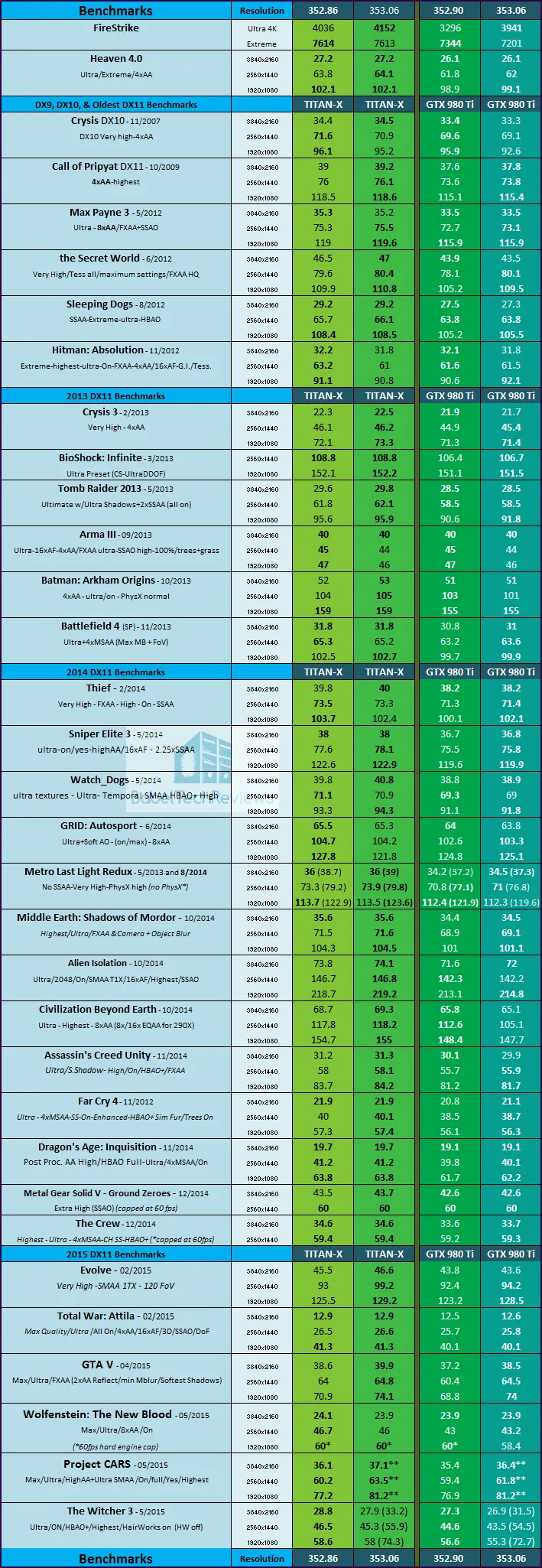As part of a regular feature for BabelTechReviews, this evaluation is comparing the performance of 31 game benchmarks with the GeForce WHQL 353.06 driver that was released the day before the Witcher 3 on May 31, versus the last Geforce WHQL 352.86 driver that was released the day before GTA V on May 18. We realize that a new WHQL driver will probably be out for the new Batman game tomorrow, but we want to document the performance changes of the current driver. We are also benching for an upcoming evaluation of the new EVGA GTX 980 Ti SC due Tuesday, and also in preparation for the launch of AMD’s Fury X on Wednesday.
 This driver performance analysis features Nvidia’s top two Maxwell cards although we plan to regularly test Kepler also in upcoming evaluations. We are going to give you the performance results of the GTX 980 Ti and the TITAN X at 1920×1080, 2560×1440, and at 3840×21600. This driver mini performance evaluation will give a natural comparison between the performance changes since Nvidia’s last WHQL driver set.
This driver performance analysis features Nvidia’s top two Maxwell cards although we plan to regularly test Kepler also in upcoming evaluations. We are going to give you the performance results of the GTX 980 Ti and the TITAN X at 1920×1080, 2560×1440, and at 3840×21600. This driver mini performance evaluation will give a natural comparison between the performance changes since Nvidia’s last WHQL driver set.
We are going to test GeForce WHQL 353.06 using our current benchmark suite of 31 games plus 2 synthetic benchmarks. Our testing platform is Windows 8.1 64-bit, using an Intel Core i7-4790K at 4.00GHz which turbso to 4.4GHz for all cores, an ASUS Z97E motherboard, and 16GB of Kingston “Beast” HyperX RAM at 2133MHz. The settings and hardware are identical except for the drivers being tested.
At GTX 760 and above, we test at higher settings and resolutions generally than we test midrange and lower-end cards. Although all of our games are now tested at three resolutions: 3840×2160, 2560×1440 and 1920×1080 at 60Hz, and we use DX11/10/10.1 whenever possible with a very strong emphasis on the latest DX11 games. We no longer benchmark 2560×1600, but now use the more popular 2560×1440 resolution beginning with this analysis.
Let’s get right to the test configuration, the driver release notes, and then to the results.
Test Configuration & Driver Release Notes
Test Configuration – Hardware
- Intel Core i7-4790K (reference 4.0GHz, HyperThreading and Turbo boost is on to 4.4GHz; DX11 CPU graphics), supplied by Intel.
- ASUS Z97-E motherboard (Intel Z97 chipset, latest BIOS, PCOe 3.0 specification, CrossFire/SLI 8x+8x)
- Kingston 16 GB HyperX Beast DDR3 RAM (2×8 GB, dual-channel at 2133MHz, supplied by Kingston)
- GeForce GTX 980, 4GB reference clocks, supplied by Nvidia
- GALAX GTX TITAN X, 12GB, reference clocks, supplied by Nvidia
- Two 2TB Toshiba 7200 rpm HDDs
- EVGA 1000G 1000W power supply unit
- Cooler Master 2.0 Seidon, supplied by Cooler Master
- Onboard Realtek Audio
- Genius SP-D150 speakers, supplied by Genius
- Thermaltake Overseer RX-I full tower case, supplied by Thermaltake
- ASUS 12X Blu-ray writer
- Monoprice Crystal Pro 4K
Test Configuration – Software
- Nvidia GeForce 353.06 WHQL drivers and GeForce 352.86 WHQL drivers for the GTX TITAN X; and for the GTX 980 Ti we used 353.06 and it’s pre-launch driver, GeForce 352.90. High Quality, prefer maximum performance, single display.
- VSync is off in the control panel.
- AA enabled as noted in games; all in-game settings are specified with 16xAF always applied; 16xAF forced in control panel for Crysis.
- All results show average, minimum and maximum frame rates except as noted.
- Highest quality sound (stereo) used in all games.
- Windows 8.1 64, all DX10 titles were run under DX10 render paths; DX11 titles under DX11 render paths. Latest DirectX
- All games are patched to their latest versions
The 31 Game benchmarks & 2 synthetic tests
- Synthetic
- Firestrike – Basic & Extreme
- Heaven 4.0
-
DX10
- Crysis
-
DX11
- STALKER, Call of Pripyat
- Max Payne 3
- the Secret World
- Sleeping Dogs
- Hitman: Absolution
- Tomb Raider: 2013
- Crysis 3
- BioShock: Infinite
- Metro: Last Light Redux (2014)
- Battlefield 4
- ArmA 3
- Batman: Arkham Origins
- Thief
- Sniper Elite 3
- Watch_Dogs
- GRID: Autosport
- Middle Earth: Shadows of Mordor
- Alien Isolation
- Assassin’s Creed Unity
- Civilization Beyond Earth
- Far Cry 4
- Dragon’s Age: Inquisition
- Metal Gear Solid V: Ground Zeroes
- The Crew
- Evolve
- Total War: Attila
- Wolfenstein: The Old Blood
- Grand Theft Auto V
- ProjectCARS
- the Witcher 3
Since the Witcher 3 is a new benchmark for BTR, the settings we use are completely maxed-out Ultra (including shadows and HairWorks), with every setting on and at the highest settings. It is a very demanding and beautiful open world game, truly “next generation” much like GTA V is. Since Hairworks take a rather significant performance hit, we are now benching with it On versus Off, much as we benchmark Metro Last Light Redux with PhysX On vs Off.
Lets look at Nvidia’s release highlights regarding the GeForce 353.06 WHQL driver before we head to performance testing.
Release Notes Highlights for GeForce 353.06
This is a really short list highlighting the fact that Nvidia’s WHQL driver release schedule is tied to the release of new games. This driver is especially for the launch of the GTX 980 Ti. In fact, the extremely brief release notes are a cut and past of the last release notes where they forgot to take out the mention of a driver alignment with the GTX Titan X. For the comprehensive release notes, you will need to download the .pdf
Just in time for the highly anticipated title Heroes of the Storm, this new GeForce Game Ready driver ensures you’ll have the best possible gaming experience. This driver is also aligned with the launch of the new flagship gaming GPU, the GeForce GTX 980 Ti. In addition, this new Game Ready driver provides a number of new gaming features and benefits based around G-SYNC technology, Dynamic Super Resolution, and enhancements for the latest new titles.
Game Ready
Best gaming experience for Heroes of the Storm, including support for GeForce Experience 1-click optimizationsNew GeForce GPU
Supports the new GeForce GTX 980 Ti GPU, based upon the second-generation Maxwell architectureGaming Technology
Supports G-SYNC technology in windowed mode, offers both G-SYNC (V-SYNC on) and G-SYNC (V-SYNC off) options, support for Ultra-Low Motion Blur (ULMB) in the NVIDIA Control Panel, provides Dynamic Super Resolution (DSR) for notebooks with discrete GeForce GPUs, and optimizations and bug fixes which can provide increased performance for Kepler-based GPUs.
Let’s head to the charts and compare the driver progress with the GTX 980 and with the GTX TITAN X since we tested them last time.
Benchmarks & Performance Analysis
Here are our results of thirty-one games and 2 synthetics compared between GeForce 352.86 WHQL drivers (and pre-launch drivers 352.90 for the Ti), and GeForce 352.86 WHQL drivers using both GTXes. Each set of WHQL drivers is compared against the other in adjoining results column and the higher performance number is in bold. If there is a tie, both results are given in bold type.
Please note that we had to create a nearly-identical benchmark for ProjectCARS as noted by a double asterisk (**), and they should not be compared directly to each other.
We note mostly minor improvements with Nvidia’s new GeForce 353.06 over the older drivers and there are only a few standouts in only a few games. However, we generally see improvement.
Conclusion:
 So far, we would recommend upgrading to the latest GeForce 353.06 driver because there are generally incremental advantages, and no large performance-impacting negatives that we encountered. It is also the driver to use for the latest really fun games that we are playing including the Witcher 3, ProjectCARS and GTA V. It appears that Nvidia intends to release a WHQL driver with each new major PC release and we are looking forward to evaluating the next one, probably later on this week.
So far, we would recommend upgrading to the latest GeForce 353.06 driver because there are generally incremental advantages, and no large performance-impacting negatives that we encountered. It is also the driver to use for the latest really fun games that we are playing including the Witcher 3, ProjectCARS and GTA V. It appears that Nvidia intends to release a WHQL driver with each new major PC release and we are looking forward to evaluating the next one, probably later on this week.
Stay tuned, next up we are benching for an upcoming evaluation of the new EVGA GTX 980 Ti SC and also for the upcoming Fury X.
Happy gaming!
